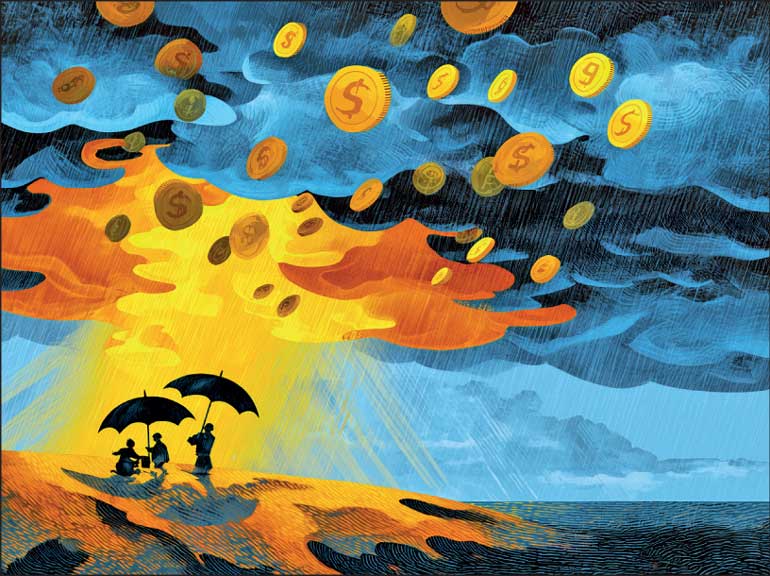Sunday Dec 14, 2025
Sunday Dec 14, 2025
Saturday, 12 July 2025 00:10 - - {{hitsCtrl.values.hits}}

While many climate impacts happen at the local level, local actors often lack the resources or capacities to adequately respond to them
 The impacts of the climate crisis are highly context-specific and manifest most acutely at the local level, where communities and other stakeholders face a complex landscape of risks. Beyond extreme weather events and other direct losses and damages, climate change also has a variety of cascading long-term consequences that affect livelihoods, economies, ecosystems, culture, health, and human lives.
The impacts of the climate crisis are highly context-specific and manifest most acutely at the local level, where communities and other stakeholders face a complex landscape of risks. Beyond extreme weather events and other direct losses and damages, climate change also has a variety of cascading long-term consequences that affect livelihoods, economies, ecosystems, culture, health, and human lives.
However, while many climate impacts happen at the local level, local actors often don’t have the resources or capacities to adequately respond to them. They require means of implementation—finance, technology, and capacity-building—that is commensurate to their challenges and aligned with principles of equity, fairness, and common but differentiated responsibilities.
What needs to be funded?
Quantifying exact numbers for loss and damage—particularly for non-economic and/or indirect losses—can be challenging, but the general needs on the ground are clear.
Local actors, such as farmer cooperatives, community associations, municipal councils, civil society organisations, or women’s groups, are aware of their challenges and possible actions to address them. For example, this could entail investment into disaster-resilient infrastructure, new crop varieties, restoration of tanks and traditional water management systems, or seed funding for climate-friendly entrepreneurs.
However, these actors are often unable to access the necessary resources to develop or implement such interventions, which is further compound by gaps in data, risk and vulnerability assessments, available technology, and other factors. Due to their lack of technical capacity for proposal development, fiduciary management and monitoring, as well as requirements to co-finance projects or absorb upfront costs, local actors are not in a position to effectively tap into climate funding, especially from multilateral funds and entities.
From this, a first takeaway emerges: To effectively reach the ground level, means of implementation for climate adaptation and responses to loss and damage should support the full project cycle, from capacity-building on risk appraisal and project design to streamlined access modalities and sustained operational funding.
Where does global funding come from?
Addressing the full spectrum of risks requires funding that is as multifaceted as the impacts themselves. Compensation for economic losses must be coupled with investments in social protection, mental health support, and ecosystem conservation. Non-economic losses, such as the erosion of cultural identity and community networks, need financing for participatory mapping, the establishment of dialogue platforms, and preservation of traditional knowledge or practices. Without resources calibrated to local contexts, efforts of resilience-building run the risk of overlooking root causes of vulnerability and perpetuating inequitable outcomes.
Under the Paris Agreement, Articles 9 to 11 enshrine finance, technology transfer, and capacity building as means of implementation. Funding sources for climate action at the global level include the operating entities of the financial mechanisms under the UNFCCC: the Green Climate Fund (GCF), Global Environment Facility (GEF), and the Fund for responding to Loss and Damage (FRLD). Furthermore, there are also other climate funds—the Adaptation Fund, the Least Developed Countries Fund, the Special Climate Change Fund—as well as multilateral development banks and international financial institutions.
A second takeaway: There is no universal one-size-fits-all solution for funding, as local impacts and needs—as well as the existing structures for access and implementation—vary greatly. However, there are lessons to be learned from the operation of existing funds and their attempts to make finance more accessible, such as through the GEF’s direct access entities or the Adaptation Fund’s direct access modalities.
What are the key challenges to overcome?
Making direct access available and building capacities of local actors to actually utilise is a complex task that includes development of a local ecosystem for adaptation, risk management, and resilience-building. Central to unlocking finance for local actors is the expansion of direct and enhanced direct access modalities without lengthy accreditation processes and requirements for technical expertise and upfront investment that exceed what local actors can deliver.
Building local capacity is indispensable and encompasses not only technical skills in project appraisal, financial management, and monitoring, evaluation, and learning, but also institutional strengthening through governance frameworks, participatory decision-making bodies, and robust accountability mechanisms. Investing in regional project preparation facilities, automatic “kick-start” funds for accredited entities, and standardised accounting packages can further lower these barriers while layered or tiered structures can decentralise decision-making while ensuring fiduciary compliance.
Equally important is harmonising global funding with national systems and priorities. National Adaptation Plans (NAPs), Nationally Determined Contributions (NDCs), and other policy documents provide strategic roadmaps for climate action. Embedding local access windows within these instruments—through dedicated budget lines, policy targets, and reporting indicators—can align subnational investments with broader adaptation goals.
The third takeaway: For access modalities to be truly inclusive, equitable, and transparent, they should be developed through participatory multi-stakeholder processes to ensure that the voices of frontline communities and vulnerable groups, as well as those of local actors in general, are taken into account.
How can we move forward?
Several pivotal entry points in 2025 and beyond offer opportunities to recalibrate climate finance further towards the local level. This includes the FRLD, which is now becoming operational, with a first application window—known as the Barbados Implementation Modalities—opening soon. This first window could serve as a testing ground for local and community-driven grants supported by participatory monitoring and evaluation systems to build an evidence base for scaling up and learn from experience.
Another entry point is presented by the Global Goal on Adaptation and the issue of means of implementation, which is currently being discussed in connection with the development of indicators to measure progress towards global adaptation targets. When defining indicators on scale, quality, and access to finance, considerations related to local access (for example, the proportion of adaptation funds reaching subnational entities or the rate of project approval for direct access proposals) could help to further highlight this question.
In addition to loss and damage and adaptation, finance is itself a central agenda item in the UNFCCC and very relevant to this question. Besides the formal negotiations, this also includes the Baku-to-Belem Roadmap to USD 1.3 trillion, which aims to find a way forward to scale up climate finance in line with the new collective quantified goal (NCQG). In this process, local access as well as local investment plans could play an important role and help to shift from centralised, project-centric financing to decentralised, program-based approaches underpinned by participatory governance.
Designing global climate funds to reach effectively the ground is not merely a financing challenge, but a test of political will, momentum, and solidarity. With strategic entry points in 2025 and beyond, the international community can ensure that those at the frontlines of climate change are not left alone, waiting for support. For developing countries, the dividends of enhanced access are clear. Investments in local actors do more than protect assets and help to nurture social cohesion, preserve cultural heritage, and foster the adaptive capacities that underpin long-term sustainable development and prosperity.
(The writer works as Director: Research & Knowledge Management at SLYCAN Trust, a non-profit think tank. His work focuses on climate change, adaptation, resilience, ecosystem conservation, just transition, human mobility, and a range of related issues. He holds a Master’s degree in Education from the University of Cologne, Germany and is a regular contributor to several international and local media outlets.)